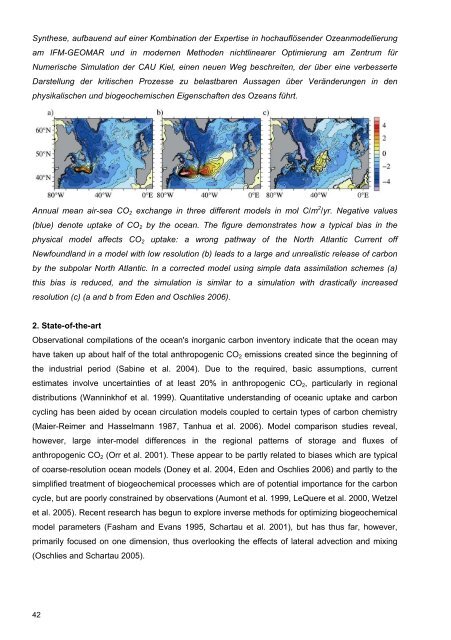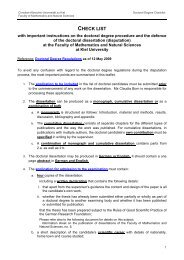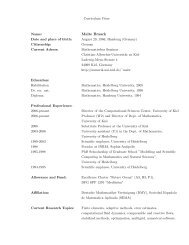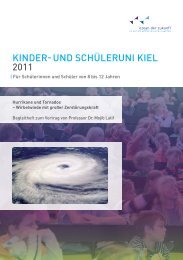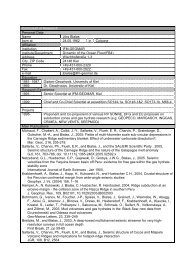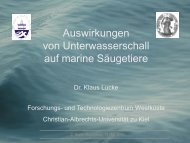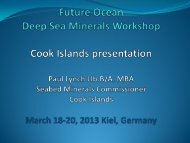Untitled - The Future Ocean
Untitled - The Future Ocean
Untitled - The Future Ocean
- No tags were found...
You also want an ePaper? Increase the reach of your titles
YUMPU automatically turns print PDFs into web optimized ePapers that Google loves.
Synthese, aufbauend auf einer Kombination der Expertise in hochauflösender Ozeanmodellierungam IFM-GEOMAR und in modernen Methoden nichtlinearer Optimierung am Zentrum fürNumerische Simulation der CAU Kiel, einen neuen Weg beschreiten, der über eine verbesserteDarstellung der kritischen Prozesse zu belastbaren Aussagen über Veränderungen in denphysikalischen und biogeochemischen Eigenschaften des Ozeans führt.Annual mean air-sea CO 2 exchange in three different models in mol C/m 2 /yr. Negative values(blue) denote uptake of CO 2 by the ocean. <strong>The</strong> figure demonstrates how a typical bias in thephysical model affects CO 2 uptake: a wrong pathway of the North Atlantic Current offNewfoundland in a model with low resolution (b) leads to a large and unrealistic release of carbonby the subpolar North Atlantic. In a corrected model using simple data assimilation schemes (a)this bias is reduced, and the simulation is similar to a simulation with drastically increasedresolution (c) (a and b from Eden and Oschlies 2006).2. State-of-the-artObservational compilations of the ocean's inorganic carbon inventory indicate that the ocean mayhave taken up about half of the total anthropogenic CO 2 emissions created since the beginning ofthe industrial period (Sabine et al. 2004). Due to the required, basic assumptions, currentestimates involve uncertainties of at least 20% in anthropogenic CO 2 , particularly in regionaldistributions (Wanninkhof et al. 1999). Quantitative understanding of oceanic uptake and carboncycling has been aided by ocean circulation models coupled to certain types of carbon chemistry(Maier-Reimer and Hasselmann 1987, Tanhua et al. 2006). Model comparison studies reveal,however, large inter-model differences in the regional patterns of storage and fluxes ofanthropogenic CO 2 (Orr et al. 2001). <strong>The</strong>se appear to be partly related to biases which are typicalof coarse-resolution ocean models (Doney et al. 2004, Eden and Oschlies 2006) and partly to thesimplified treatment of biogeochemical processes which are of potential importance for the carboncycle, but are poorly constrained by observations (Aumont et al. 1999, LeQuere et al. 2000, Wetzelet al. 2005). Recent research has begun to explore inverse methods for optimizing biogeochemicalmodel parameters (Fasham and Evans 1995, Schartau et al. 2001), but has thus far, however,primarily focused on one dimension, thus overlooking the effects of lateral advection and mixing(Oschlies and Schartau 2005).42


